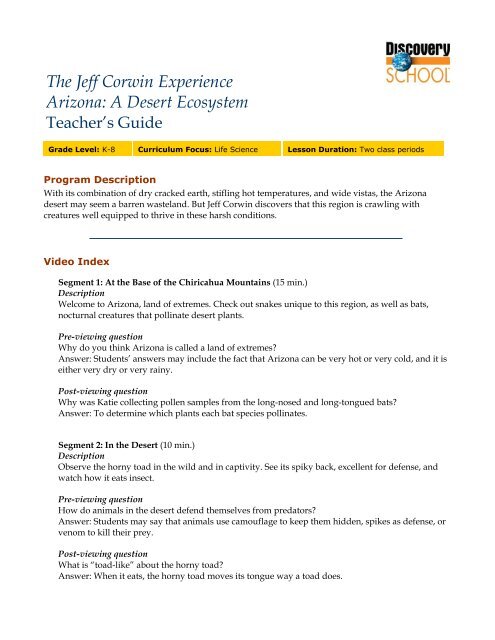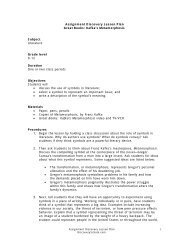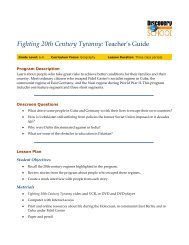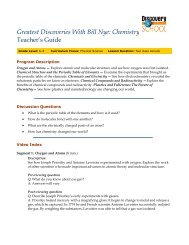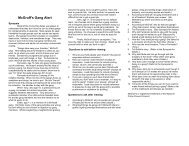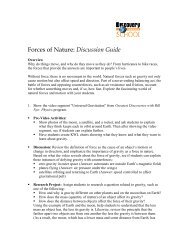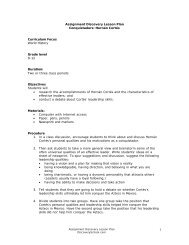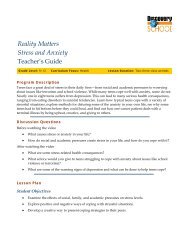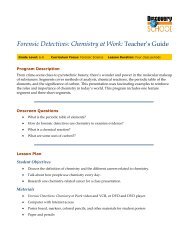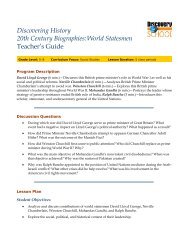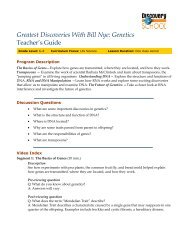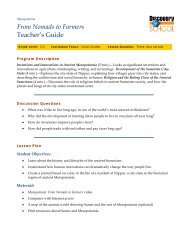The Jeff Corwin Experience: Arizona: A Desert Ecosystem
The Jeff Corwin Experience: Arizona: A Desert Ecosystem
The Jeff Corwin Experience: Arizona: A Desert Ecosystem
Create successful ePaper yourself
Turn your PDF publications into a flip-book with our unique Google optimized e-Paper software.
<strong>The</strong> <strong>Jeff</strong> <strong>Corwin</strong> <strong>Experience</strong><br />
<strong>Arizona</strong>: A <strong>Desert</strong> <strong>Ecosystem</strong><br />
Teacher’s Guide<br />
Grade Level: K-8 Curriculum Focus: Life Science Lesson Duration: Two class periods<br />
Program Description<br />
With its combination of dry cracked earth, stifling hot temperatures, and wide vistas, the <strong>Arizona</strong><br />
desert may seem a barren wasteland. But <strong>Jeff</strong> <strong>Corwin</strong> discovers that this region is crawling with<br />
creatures well equipped to thrive in these harsh conditions.<br />
Video Index<br />
Segment 1: At the Base of the Chiricahua Mountains (15 min.)<br />
Description<br />
Welcome to <strong>Arizona</strong>, land of extremes. Check out snakes unique to this region, as well as bats,<br />
nocturnal creatures that pollinate desert plants.<br />
Pre-viewing question<br />
Why do you think <strong>Arizona</strong> is called a land of extremes?<br />
Answer: Students’ answers may include the fact that <strong>Arizona</strong> can be very hot or very cold, and it is<br />
either very dry or very rainy.<br />
Post-viewing question<br />
Why was Katie collecting pollen samples from the long-nosed and long-tongued bats?<br />
Answer: To determine which plants each bat species pollinates.<br />
Segment 2: In the <strong>Desert</strong> (10 min.)<br />
Description<br />
Observe the horny toad in the wild and in captivity. See its spiky back, excellent for defense, and<br />
watch how it eats insect.<br />
Pre-viewing question<br />
How do animals in the desert defend themselves from predators?<br />
Answer: Students may say that animals use camouflage to keep them hidden, spikes as defense, or<br />
venom to kill their prey.<br />
Post-viewing question<br />
What is “toad-like” about the horny toad?<br />
Answer: When it eats, the horny toad moves its tongue way a toad does.
<strong>Arizona</strong>: A <strong>Desert</strong> <strong>Ecosystem</strong><br />
Teacher’s Guide 2<br />
Segment 3: Life in an Airfield (6 min.)<br />
Description<br />
In <strong>Arizona</strong>, life thrives everywhere—even in an airfield. Observe a family of owls and see how a<br />
spadefoot toad digs itself an underground home.<br />
Pre-viewing question<br />
Why would animals live in an airfield?<br />
Answer: Answers may include that as habitats change, many animals can adapt and continue to<br />
thrive.<br />
Post-viewing question<br />
What is one interesting characteristic of the gecko in <strong>Arizona</strong>?<br />
Answer: It has eyelids and it can blink.<br />
Segment 4: Visiting Sonora National Park (6 min.)<br />
Description<br />
Explore Sonora National Park and one of the local snakes. Meet a scientist who tracks snakes, and<br />
observe <strong>Jeff</strong> assist in snake surgery.<br />
Pre-viewing question<br />
Why do scientists study snakes?<br />
Answer: Answers may include learning more about their habits or how they survive.<br />
Post-viewing question<br />
Why did the snake undergo surgery?<br />
Answer: <strong>The</strong> transmitter inside the snake had to be replaced so the scientist could continue tracking<br />
it.<br />
Segment 5: Saguaro National Park (6 min.)<br />
Description<br />
Visit Saguaro National Park, named for the giant cacti that grow there. Meet a desert tortoise, an<br />
animal that has adapted well to the dry habitat.<br />
Pre-viewing question<br />
Why do saguaro cactus plants grow so tall?<br />
Answer: Answers will vary; some students may learn that these plants live a long time.<br />
Post-viewing question<br />
How has the desert tortoise adapted to its environment?<br />
Answer: Students may mention that tortoises use camouflage or how they use their bladders as a<br />
water reserve.<br />
Published by Discovery Education. © 2005. All rights reserved.
<strong>Arizona</strong>: A <strong>Desert</strong> <strong>Ecosystem</strong><br />
Teacher’s Guide 3<br />
Lesson Plan<br />
Student Objectives<br />
• Research animals that live in the desert in <strong>Arizona</strong>.<br />
• Investigate how animals have developed unique adaptations for survival in a desert<br />
environment.<br />
• Create a class scrapbook that features desert animals in <strong>Arizona</strong>.<br />
Materials<br />
• <strong>The</strong> <strong>Jeff</strong> <strong>Corwin</strong> <strong>Experience</strong>: <strong>Arizona</strong>: A <strong>Desert</strong> <strong>Ecosystem</strong> video and VCR, DVD and DVD player<br />
• Computer(s) with Internet access<br />
• Newsprint and markers<br />
Procedures<br />
1. Begin the lesson by asking students what they know or imagine about life in the desert of<br />
<strong>Arizona</strong>. Is the weather always dry, or does it ever rain? How can animals and plants survive<br />
there? Write their ideas on a sheet of newsprint.<br />
2. Tell students that in <strong>The</strong> <strong>Jeff</strong> <strong>Corwin</strong> <strong>Experience</strong>: <strong>Arizona</strong>: <strong>Desert</strong> <strong>Ecosystem</strong> they will see animals<br />
that live in the harsh desert environment. Show segments 2 (“In the <strong>Desert</strong>”) and 5 (“Saguaro<br />
National Park”) so that students can see how animals adapt.<br />
3. Give students an opportunity to learn more about the desert animals. Group students into pairs,<br />
and have each pair select an animal to research. Suggest choosing an animal from the list below,<br />
all of which are featured in the video.<br />
• Texas horned lizard, also called horny toad<br />
• Couch’s spadefoot toad<br />
• desert tortoise<br />
• Western diamondback rattlesnake<br />
• Mojave rattlesnake<br />
• <strong>Arizona</strong> mountain king snake<br />
• Coleonyx gecko<br />
• Gila monster<br />
4. <strong>The</strong> following Web sites have additional information about these animals:<br />
• http://www.desertusa.com/mag98/dec/stories/desmuseum.html<br />
• http://www.blueplanetbiomes.org/sonoran_desert.htm<br />
• http://www.desertusa.com/animal.html<br />
Published by Discovery Education. © 2005. All rights reserved.
<strong>Arizona</strong>: A <strong>Desert</strong> <strong>Ecosystem</strong><br />
Teacher’s Guide 4<br />
5. Have students complete their research at home. During the next class period, have each pair<br />
develop a page for a class scrapbook about <strong>Arizona</strong> desert animals. Each page should include<br />
the following:<br />
• a photograph or illustration of the animal<br />
• a description of the animal<br />
• one or two sentences explaining its adaptation to desert life<br />
6. Some animals may have more than one scrapbook page, depending on the number of students.<br />
If a pair finishes early, ask them to design a scrapbook cover.<br />
7. At the end of this period, collect each page and assemble them with the cover to share with the<br />
class. Leave the scrapbook for visitors to the class.<br />
Assessment<br />
Use the following three-point rubric to evaluate students’ work during this lesson.<br />
Vocabulary<br />
• 3 points: Students were highly engaged in class and small group discussions; researched the<br />
topic carefully and thoroughly; produced a creative, informative, and accurate scrapbook<br />
page that included all of the requested information.<br />
• 2 points: Students participated in class and small group discussions; researched the topic<br />
adequately; produced a satisfactory scrapbook page that included most of the requested<br />
information.<br />
• 1 point: Students participated minimally in class and small group discussions; did not<br />
research the topic adequately; produced an incomplete scrapbook page, with little or none<br />
of the requested information.<br />
adaptation<br />
Definition: A body structure or a behavior that enables an animal to survive in its environment<br />
Context: <strong>The</strong> animals of the <strong>Arizona</strong> desert have developed unique adaptations that enable them to<br />
survive in a harsh environment.<br />
<strong>Arizona</strong> mountain king snake<br />
Definition: A snake that belongs to the constrictor group, which kill prey by strangling it<br />
Context: <strong>The</strong> <strong>Arizona</strong> mountain king snake’s dangerous-looking bands of color send a message to<br />
predators to stay away.<br />
Published by Discovery Education. © 2005. All rights reserved.
<strong>Arizona</strong>: A <strong>Desert</strong> <strong>Ecosystem</strong><br />
Teacher’s Guide 5<br />
desert<br />
Definition: An environment that is hot and dry, with little or sporadic rainfall each year<br />
Context: <strong>The</strong> desert is such a harsh place, so only the hardiest and well-adapted animals can survive<br />
there.<br />
desert tortoise<br />
Definition: A burrowing tortoise of the arid western United States that can go without water for long<br />
periods<br />
Context: <strong>Jeff</strong> <strong>Corwin</strong> didn’t pick up the desert tortoise because might waste precious water it holds<br />
in its bladder.<br />
Gila monster<br />
Definition: A rare lizard that has toxic venom, an unusual trait for this kind of reptile<br />
Context: <strong>The</strong> Gila monster is highly venomous, so try to avoid encountering one in the desert.<br />
Texas horned lizard<br />
Definition: A type of lizard; nicknamed “horny toad” because it eats in much the same way as a toad<br />
Context: <strong>The</strong> Texas horned lizard takes full advantage of rainfall by using the surface of its body to<br />
channel water into its mouth.<br />
Academic Standards<br />
National Academy of Sciences<br />
<strong>The</strong> National Academy of Sciences provides guidelines for teaching science in grades K–12 to<br />
promote scientific literacy. To view the standards, visit this Web site:<br />
http://books.nap.edu/html/nses/html/overview.html#content.<br />
Grades K-4<br />
• Life Science: Organisms and environments<br />
Grades 5-8<br />
• Life Science: Populations and ecosystems, Life Science: Diversity and adaptations of<br />
organisms<br />
Mid-continent Research for Education and Learning (McREL)<br />
McREL’s Content Knowledge: A Compendium of Standards and Benchmarks for K-12 Education<br />
addresses 14 content areas. To view the standards and benchmarks, visit<br />
http://www.mcrel.org/compendium/browse.asp.<br />
• Language Arts—Viewing: Uses viewing skills and strategies to understand and interpret<br />
visual media; Writing: Gathers and uses information for research purposes<br />
Published by Discovery Education. © 2005. All rights reserved.
<strong>Arizona</strong>: A <strong>Desert</strong> <strong>Ecosystem</strong><br />
Teacher’s Guide 6<br />
Support Materials<br />
Develop custom worksheets, educational puzzles, online quizzes, and more with the free teaching tools<br />
offered on the Discoveryschool.com Web site. Create and print support materials, or save them to a<br />
Custom Classroom account for future use. To learn more, visit<br />
• http://school.discovery.com/teachingtools/teachingtools.html<br />
Published by Discovery Education. © 2005. All rights reserved.


